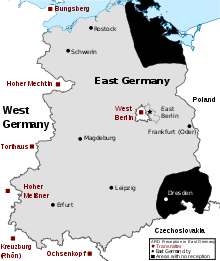Tal der Ahnungslosen

Tal der Ahnungslosen (Valley of the Clueless) was a satirical designation for two regions in the southeast and northeast parts of the former East Germany that generally were not able to receive TV programming from West Germany from the mid-to-late 1950s, including the public broadcasters ARD and ZDF, to late 1989 into 1990 after the Fall of the Berlin Wall in November 1989 and prior to German reunification in October 1990.[1][2]
East Germans used the name ARD with the abbreviation jokingly standing for "Außer (except) Rügen und Dresden" since the programmes could be seen in every other part of East Germany, such as Erfurt, Leipzig, Magdeburg, and Schwerin. West German television stations were widely considered to be more reliable in their coverage than their Communist East German counterparts and therefore the people who could not receive those stations were thought to be less well informed about the contemporary situation in their country and in the world,[3] despite having access to some Western radio.
From the late 1970s onwards as the East German authorities became resigned to the presence of Westfernsehen and with the introduction of cable (and later satellite) technologies the number of East German residents (even in areas far from the border) without access to at least one channel from the West declined further.
See also
External links
- Fernsehempfang im Tal der Ahnungslosen Television reception in Tal der Ahnungslosen
- Im Tal der Ahnungslosen - Westfernsehen Marke Eigenbau Homegrown West TV
- Video (in German)